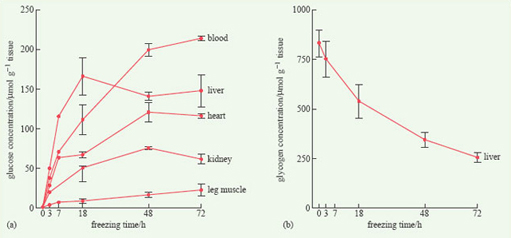1.4.3 Freeze tolerance in ectothermic vertebrates
In Britain, the vertebrate class Amphibia is represented by frogs, toads and newts. Amphibians are ectotherms, meaning that they are unable to generate large quantities of heat within their bodies, so their body temperature is close to that of their surroundings. The majority of amphibian species avoid the lethal consequences of being frozen, by digging their way under a large object, such as a rock, or deep into the soil, below the level that is penetrated by frost. There are some species, however, that have evolved a physiological response to very cold weather that enables them to survive the winter on or close to the ground surface. Examples include the American wood frog (Rana sylvatica) and the Asian salamander (Hynobius kyserlingi), both of which have distributions that extend far north of the Arctic circle. What they do is to infuse their tissues with antifreeze.
In the wood frog, the onset of cold causes the animal to become immobile. As the temperature falls below 0°C, water in its toes begins to freeze. Within 10-15 minutes of freezing, glycogen stored in the liver is converted into soluble glucose which is released into the bloodstream, whence it finds its way into the cells and the extracellular spaces (Figure 14). The dissolved glucose lowers the freezing point of water, as antifreeze does in a car's radiator, preventing the formation of ice crystals and any consequent movement of water out of living cells.

Whereas the wood frog uses glucose as an antifreeze, the Asian salamander and the grey treefrog (Hyla versicolor) use glycerol, suggesting that this adaptation may have evolved independently in a number of amphibian species. Freeze tolerance allows these amphibians to survive freezing conditions for one or two weeks. It is not their only adaptation for surviving the winter; in the wood frog, for example, breathing ceases and the heart stops beating at very low temperatures.
Some ectothermic vertebrates rely on supercooling to survive short periods of cold temperature (see Section 1.2.1). For example, the spring lizard (Sceloporus jarrovi), living in the Arizona desert, survives very cold nights by supercooling. This strategy is risky, however, and many lizards die as a result of becoming frozen. Allowing its tissues to supercool is not a viable option for a frog or salamander; living in damp places, they are virtually certain to be in contact with ice crystals which act as nucleation points.
As well as enabling them to survive frosty conditions, the capacity to tolerate extreme cold confers other advantages on some amphibians. Many breed in temporary ponds that dry up early in the spring or summer, making it advantageous for breeding adults to migrate to ponds as early as possible in the spring. Early breeding maximises the time available for the aquatic egg and larval stages to be completed before a pond dries up. Some species, such as the American blue-spotted salamander (Ambystoma laterale) migrate to breeding ponds while snow is still on the ground, giving them an advantage over other salamander species that do not start to breed until the weather is warm.
